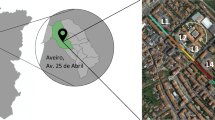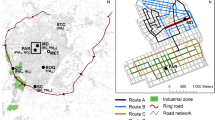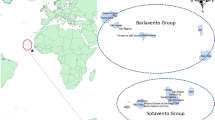Abstract
Emission inventories are one of the most critical inputs for the successful modeling of air quality. The performance of the modeling results is directly affected by the quality of atmospheric emission inventories. Consequently, the development of representative inventories is always required. Due to the lack of regional inventories in Brazil, this study aimed to investigate the use of the particulate matter (PM) emission estimation from the Brazilian top-down vehicle emission inventory (VEI) of 2012 for air quality modeling. Here, we focus on road vehicles since they are usually responsible for significant emissions of PM in urban areas. The total Brazilian emission of PM (63,000 t year−1) from vehicular sources was distributed into the urban areas of 5557 municipalities, with 1-km2 grid spacing, considering two approaches: (i) population and (ii) fleet of each city. A comparison with some local inventories is discussed. The inventory was compiled in the PREP-CHEM-SRC processor tool. One-month modeling (August 2015) was performed with WRF-Chem for the four metropolitan areas of Brazilian Southeast: Belo Horizonte (MABH), Great Vitória (MAGV), Rio de Janeiro (MARJ), and São Paulo (MASP). In addition, modeling with the Emission Database for Global Atmospheric Research (EDGAR) inventory was carried out to compare the results. Overall, EDGAR inventory obtained higher PM emissions than the VEI segregated by population and fleet, which is expected owing to considerations of additional sources of emission (e.g., industrial and residential). This higher emission of EDGAR resulted in higher PM10 and PM2.5 concentrations, overestimating the observations in MASP, while the proposed inventory well represented the ambient concentrations, obtaining better statistics indices. For the other three metropolitan areas, both EDGAR and the VEI inventories obtained consistent results. Therefore, the present work endorses the fact that vehicles are responsible for the more substantial contribution to PM emissions in the studied urban areas. Furthermore, the use of VEI can be representative for modeling air quality in the future.









Similar content being viewed by others
References
Albuquerque TTA, Andrade MF, Ynoue RY, Moreira DM, Andreão WL, Santos FS, Nascimento EGS (2018) WRF-SMOKE-CMAQ modeling system for air quality evaluation in São Paulo megacity with a 2008 experimental campaign data. Environ Sci Pollut Res 25:36555–36569. https://doi.org/10.1007/s11356-018-3583-9
Albuquerque TTA, West J, Andrade MF, Ynoue RY, Andreão WL, Santos FS, Maciel FM, Pedruzzi R, Mateus VO, Martins JA, Martins LD, Nascimento EGS, Moreira DM (2019) Analysis of PM2.5 concentrations under pollutant emission control strategies in the metropolitan area of São Paulo, Brazil. Environ Sci Pollut Res 26:33216–33227. https://doi.org/10.1007/s11356-019-06447-6
Alonso MF, Longo K, Freitas S, Fonseca R, Marécal V, Pirre M, Klenner L (2010) An urban emission inventory for South America and its application in numerical modeling of atmospheric chemical composition at local and regional scales. Atmos Environ 44:5072–5083. https://doi.org/10.1016/j.atmosenv.2010.09.013
Andrade MF, Kumar P, Freitas ED, Ynoue RY, Martins J, Martins LD, Nogueira T, Perez-Martinez P, Miranda RM, Albuquerque T, Gonçalves FLT, Oyama B, Zhang Y (2017) Air quality in the megacity of São Paulo: evolution over the last 30 years and future perspectives. Atmos Environ 159:66–82. https://doi.org/10.1016/j.atmosenv.2017.03.051
Andreão WL, Albuquerque TTA, Kumar P (2018) Excess deaths associated with fine particulate matter in Brazilian cities. Atmos Environ 194:71–81. https://doi.org/10.1016/j.atmosenv.2018.09.034
Archer-Nicholls S, Lowe D, Darbyshire E, Morgan WT, Bela MM, Pereira G, Trembath J, Kaiser JW, Longo KM, Freitas SR, Coe H, McFiggans G (2015) Characterising Brazilian biomass burning emissions using WRF-Chem with MOSAIC sectional aerosol. Geosci Model Dev 8:549–577. https://doi.org/10.5194/gmd-8-549-2015
Avolio E, Federico S, Miglietta MM, Lo Feudo T, Calidonna CR, Sempreviva AM (2017) Sensitivity analysis of WRF model PBL schemes in simulating boundary layer variables in southern Italy: an experimental campaign. Atmos Res 192:58–71. https://doi.org/10.1016/j.atmosres.2017.04.003
Brazil (2013). Inventário nacional de emissões atmosféricas por veículos automotores rodoviários 2013, ano base 2012. Available online < http://www.antt.gov.br/backend/galeria/arquivos/inventario_de_emissoes_por_veiculos_rodoviarios_2013.pdf> Accessed in June, 2019
Cain ML (1989) The analysis of angular data in ecological field studies. Ecology 70:1540–1543. https://doi.org/10.2307/1938211
CETESB (2016) Emissões veiculares 2015. São Paulo, CETESB
Chang, J.S., Binkowki, F.S., Seaman, N.L., McHenry, J.N., Samson, P.J., Stockwell, W.R., Walcek, C.J., Madronich, S., Middleton, P.B., Pleim, J.E., Lansford, H.H.: The regional acid deposition model and engineering model, State-of-Science/Technology, Report 4, National Acid Precipitation Assessment Program, Washington, DC, 1989
Chen F, Dudhia J (2001) Coupling an advanced land surface-hydrology model with the Penn State-NCAR MM5 modeling system, part I: model implementation and sensitivity. Mon Weather Rev 129:569–585. https://doi.org/10.1175/1520-0493(2001)129<0569:CAALSH>2.0.CO;2
Chin M, Rood RB, Lin S, Müller J-F, Thompson AM (2000) Atmospheric sulfur cycle simulated in the global model GOCART - model description and global properties. J Geophys Res Atmos 105:24671–24687. https://doi.org/10.1029/2000JD900384
Dandou A, Tombrou M, Kalogiros J, Bossioli E, Biskos G, Mihalopoulos N, Coe H (2017) Investigation of turbulence parametrization schemes with reference to the atmospheric boundary layer over the Aegean Sea during etesian winds. Bound-Layer Meteorol 164:303–329. https://doi.org/10.1007/s10546-017-0255-0
Emery, C., Tai, E., Yarwood, G., (2001). Enhanced meteorological modeling and performance evaluation for two Texas ozone episodes. Work Assignment No. 31984-11. TNRCC Umbrella Contract No. 582-0-31984
Emery C, Liu Z, Russell AG, Talat Odman M, Yarwood G, Kumar N (2017) Recommendations on statistics and benchmarks to assess photochemical model performance. J Air Waste Manage Assoc 5:582–598. https://doi.org/10.1080/10962247.2016.1265027
Freitas SR, Longo KM, Alonso MF, Pirre M, Marecal V, Grell G, Stockler R, Meloo RF, Gácita MS (2011) PREP-CHEM-SRC – 1.0: a preprocessor of trace gas and aerossol emission fields for regional and global atmospheric chemistry models. Geosci Model Dev 4:419–433. https://doi.org/10.5194/gmd-4-419-2011
Freitas CUD, Junger W, Leon APD, Grimaldi R, Silva MAFR, Gouveia N (2013) Poluição do ar em cidades brasileiras: selecionando indicadores de impacto na saúde para fins de vigilância. Epidemiologia e Serviços de Saúde 22(445–454):2013. https://doi.org/10.5123/S1679-49742013000300009
Freitas SR, Panetta J, Longo KM, Rodrigues LF, Moreira DS, Rosário NE, Silva Dias PL, Silva Dias MAF, Souza EP, Freitas ED, Longo M, Frassoni A, Fazenda AL, Santos E, Silva CM, Pavani CAB, Eiras D, França DA, Massaru D, Silva FB, Santos FC, Pereira G, Camponogara G, Ferrada GA, Campos Velho HF, Menezes I, Freire JL, Alonso MF, Gácita MS, Zarzur M, Fonseca RM, Lima RS, Siqueira RA, Braz R, Tomita S, Oliveira V, Martins LD (2017) The Brazilian developments on the Regional Atmospheric Modeling System (BRAMS 5.2): an integrated environmental model tuned for tropical areas. Geosci Model Dev 10:189–222. https://doi.org/10.5194/gmd-10-189-2017
Fisher NI, Lee AJ (1983) A correlation coefficient for circular data source. Biometrika 70:327–332. https://doi.org/10.2307/2335547
Gao M, Guttikunda SK, Carmichael GR, Wang Y, Liu Z, Stanier CO, Saide PE, Yu M (2015) Health impacts and economic losses assessment of the 2013 severe haze event in Beijing area. Sci Total Environ 511:553–561. https://doi.org/10.1016/j.scitotenv.2015.01.005
Gavidia-Calderón M, Vara-Vela A, Crespo NM, Andrade MF (2018) Impact of time-dependent chemical boundary conditions on tropospheric ozone simulation with WRF-Chem: an experiment over the metropolitan area of São Paulo. Atmos Environ 195:112–124. https://doi.org/10.1016/j.atmosenv.2018.09.026
Gómez CD, González CM, Osses M, Aristizábal BH (2018) Spatial and temporal disaggregation of the on-road vehicle emission inventory in a medium-sized Andean city. Comparison of GIS-based top-down methodologies. Atmos Environ 179:142–155. https://doi.org/10.1016/j.atmosenv.2018.01.049
Gouveia N, Junger WL (2018) Effects of air pollution on infant and children respiratory mortality in four large Latin-American cities. Environ Pollut 232:385–391. https://doi.org/10.1016/j.envpol.2017.08.125
Grell GA, Peckham SE, Schmitz R, Mckeen SA, Frost G, Skamarock WC, Eder B (2005) Fully coupled “online” chemistry within the WRF model. Atmos Environ 39:6957–6975. https://doi.org/10.1016/j.atmosenv.2005.04.027
Guerrette JJ, Henze DK (2015) Development and application of the WRFPLUS-Chem online chemistry adjoint and WRFDA-Chem assimilation system. Geosci Model Dev 8:1857–1876. https://doi.org/10.5194/gmd-8-1857-2015
Hogrefe C, Roselle SJ, Bash JO (2017) Persistence of initial conditions in continental scale air quality simulations. Atmos Environ 160:36–45. https://doi.org/10.1016/j.atmosenv.2017.04.009
Hong SY, Noh Y, Dudhia J (2006) A new vertical diffusion package with an explicit treatment of entrainment processes. Mon Weather Rev 134:2318–2341. https://doi.org/10.1175/MWR3199.1
Iacono MJ, Delamere JS, Mlawer EJ, Shephard MW, Clough SA, Collins WD (2008) Radiative forcing by long-lived greenhouse gases: calculations with the AER radiative transfer models. J Geophys Res 113:D13103. https://doi.org/10.1029/2008JD009944
Ibarra-Espinosa S, Ynoue RY, Ropkins K, Zhang X, Freitas ED (2020) High spatial and temporal resolution vehicular emissions in south-east Brazil with traffic data from real-time GPS and travel demand models. Atmos Environ 222:117136. https://doi.org/10.1016/j.atmosenv.2019.117136
IEMA (2019) Inventário de emissões atmosféricas Região da Grande Vitória ano-base 2015. Vitória, IEMA/EcoSoft
INEA (2016) Inventário emissões de fontes veiculares Região Metropolitana do Rio de Janeiro ano-base 2013. INEA, Rio de Janeiro
Jammalamadaka SR, Lund UJ (2006) The effect of wind direction on ozone levels: a case study. Environ Ecol Stat 13:287–298. https://doi.org/10.1007/s10651-004-0012-7
Janssens-Maenhout G, Crippa M, Guizzardi D, Dentener F, Muntean M, Pouliot G, Keating T, Zhang Q, Kurokawa J, Wankmüller R, Denier van der Gon H, Kuenen JJP, Klimont Z, Frost G, Darras S, Koffi B, Li M (2015) HTAP_v2.2: a mosaic of regional and global emission grid maps for 2008 and 2010 to study hemispheric transport of air pollution. Atmos Chem Phys 15(19):11411–11432. https://doi.org/10.5194/acp-15-11411-2015
Janssens-Maenhout, G., Pagliari, V., and Muntean, M.(2013) Global emission inventories in the Emission Database for Global Atmospheric Research (EDGAR) – Manual (I): Gridding: EDGAR emissions distribution on global grid maps, Tech. Rep. 25785, JRC
Jiménez, P.A, Dudhia, J., 2013. On the ability of the WRF model to reproduce the surface wind direction over complex terrain. J Appl Meteorol Climatol 52, 1610–1617. https://doi.org/10.1175/JAMC-D-12-0266.1
Jiménez PA, Dudhia J, González-Rouco JF, Navarro J, Montávez JP, García-Bustamante E (2012) A revised scheme for the WRF surface layer formulation. Mon Weather Rev 140:898–918. https://doi.org/10.1175/MWR-D-11-00056.1
Lake Michigan Air Directors Consortium (LADCO), Wisconsin Department of Natural Resources (WDNR), 2018. 2016 Weather Research and Forecasting (WRF) Modeling Protocol for the LADCO states. LADCO and WDNR, Rosemont and Madison. Available online <https://www.ladco.org/wp-content/uploads/Modeling/2016/WRF/LADCO_WRF2016_ModelingProtocol_Final.pdf>. Acessed in October, 2019
Ma Y, Yang Y, Mai X, Qiu C, Long X, Wang C (2016) Comparison of analysis and spectral nudging techniques for dynamical downscaling with the WRF model over China. Adv Meteorol:4761513. https://doi.org/10.1155/2016/4761513
Martins, J.A., Martins, L.D., Freitas, E.D., Mazzoli, C.A., Hallak, R., Andrade, M.F. (2008). Aplicação de imagens de satélite no desenvolvimento de inventários de emissão de alta resolução. In: XV Congresso Brasileiro de Meteorologia, São Paulo. Anais do XV CBMET, 24 a 29 de agosto de 2008, pp. 1–5 (CD)
Martins JA, Mazzoli CR, OliveiraMGL YRY, AndradeMF FED, Martins LD (2010) Desenvolvimento de inventários de emissão de alta resolução: Intensidade de luzes noturnas e distribuição espacial de veículos. Paper presented at the XVI Congresso Brasileiro de Meteorologia. Belém, Brazil
Miranda RM, Andrade MF, Fornaro A, Astolfo R, Andre PA, Saldiva P (2012) Urban air pollution: a representative survey of PM2.5 mass concentrations in six Brazilian cities. Air Qual Atmos Health 5:63–77. https://doi.org/10.1007/s11869-010-0124-1
Miranda RM, Perez-Martinez PJ, Andrade MF, Ribeiro FND (2019) Relationship between black carbon (BC) and heavy traffic in São Paulo, Brazil. Transp Res Part D: Transp Environ 68:84–98. https://doi.org/10.1016/j.trd.2017.09.002
Morrison H, Thompson G, Tatarskii V (2009) Impact of cloud microphysics on the development of trailing stratiform precipitation in a simulated squall line: comparison of one- and two-moment schemes. Mon Weather Rev 137:991–1007. https://doi.org/10.1175/2008MWR2556.1
Mues A, Lauer A, Lupascu A, Rupakheti M, Kuik F, Lawrence MG (2018) WRF and WRF-Chem v3.5.1 simulations of meteorology and black carbon concentrations in the Kathmandu Valley. Geosci Model Dev 11:2067–2091. https://doi.org/10.5194/gmd-11-2067-2018
Mughal MO, Lynch M, Yu F, McGann B, Jeanneret F, Sutton J (2017) Wind modeling, validation and sensitivity study using Weather Research and Forecasting model in complex terrain. Environ Model Softw 90:107–125. https://doi.org/10.1016/j.envsoft.2017.01.009
Pacheco MT, Parmigiani MMM, Andrade MF, Morawska L, Kumar P (2017) A review of emissions and concentrations of particulate matter in the three metropolitan areas of Brazil. J Transp Health 4:53–72. https://doi.org/10.1016/j.jth.2017.01.008
Pedruzzi R, Baek BH, Henderson BH, Aravanis N, Pinto JA, Araujo IB, Nascimento EGS, Reis Junior NC, Moreira DM, Albuquerque TTA (2019) Performance evaluation of a photochemical model using different boundary conditions over the urban and industrialized metropolitan area of Vitória, Brazil. Environ Sci Pollut Res 26:16125–16144. https://doi.org/10.1007/s11356-019-04953-1
Papanastasiou DK, Melas D, Lissaridis I (2010) Study of wind field under sea breeze conditions; an application of WRF model. Atmos Res 98:102–117. https://doi.org/10.1016/j.atmosres.2010.06.005
Peng Z, Liu Z, Chen D, Ban J (2017) Improving PM2:5 forecast over China by the joint adjustment of initial conditions and source emissions with an ensemble Kalman filter. Atmos Chem Phys 17:4837–4855. https://doi.org/10.5194/acp-17-4837-2017
Permadi DA, Oanh NTK, Vautard R (2018) Integrated emission inventory and modeling to assess distribution of particulate matter mass and black carbon composition in Southeast Asia. Atmos Chem Phys 18:2725–2747. https://doi.org/10.5194/acp-18-2725-2018
Pinto JA, Kumar P, Alonso MF, Andreão WL, Pedruzzi R, Santos FS, Moreira DM, Albuquerque TTA (2020a) Traffic data in air quality modeling: a review of key variables, improvements in results, open problems and challenges in current research. Atmos Pollut Res 11:454–468. https://doi.org/10.1016/j.apr.2019.11.018
Pinto JA, Kumar P, Alonso MF, Andreão WL, Pedruzzi R, Espinosa S, Albuquerque TTA (2020b) Kriging method application and traffic behavior profiles from local radar network database: a proposal to support traffic solutions and air pollution control strategies. Sustain Cities Soc 102062. https://doi.org/10.1016/j.scs.2020.102062
Policarpo NA, Silva C, Lopes TFA, Araújo RS, Cavalcante FSA, Pitombo CS, Oliveira MLM (2018) Road vehicle emission inventory of a Brazilian metropolitan area and insights for other emerging economies. Transp Res D 58:172–185. https://doi.org/10.1016/j.trd.2017.12.004
Pulles T, Heslinga D (2010) The art of emission inventorying. TNO, Utrecht, ISBN: 9789059863415
Ramboll US Corporation, (2018). PacWest Newport Meteorological Performance Evaluation. Ramboll US Corporation, Washington. Available online <https://stopnewportsmelter.org/wp-content/uploads/2018/10/PacWest_WRFMMIF_ MPE.pdf>. Acessed in October, 2019
Réquia WJ Jr, Koutrakis P, Roig HL (2015) Spatial distribution of vehicle emission inventories in the Federal District, Brazil. Atmos Environ 112:32–39 https://doi.org/10.1016/j.atmosenv.2015.04.029
Réquia WJ Jr, Koutrakis P, Roig HL, Adams MD (2016) Spatiotemporal analysis of traffic emissions in over 5000 municipal districts in Brazil. J Air Waste Manage Assoc 66(12):1284–1293 https://doi.org/10.1080/10962247.2016.1221367
Russo MA, Gama C, Monteiro A (2019) How does upgrading an emissions inventory affect air quality simulations? Air Qual Atmos Health 12:731–741. https://doi.org/10.1007/s11869-019-00692-x
Santos, Fábio S dos. (2018) Diagnóstico das emissões atmosféricas em Minas Gerais: um estudo para as fontes fixas e veiculares. Master dissertation. Universidade Federal de Minas Gerais, Belo Horizonte,
Schwartz, C.S., Liu, Z., Lin, H.-C., McKeen, S.A., 2012. Simultaneous three-dimensional variational assimilation of surface fine particulate matter and MODIS aerosol optical depth. J Geophys Res 117, D13202. https://doi.org/10.1029/2011JD017383, 2012
Shimada S, Ohsawa T, Chikaoka S, Kozai K (2011) Accuracy of the wind speed profile in the lower PBL as simulated by the WRF model. SOLA 7:109–112. https://doi.org/10.2151/sola.2011-028
Simon S, Baker KR, Phillips S (2012) Compilation and interpretation of photochemical model performance statistics published between 2006 and 2012. Atmos Environ 61:124–139. https://doi.org/10.1016/j.atmosenv.2012.07.012
Souza, J. B. De; Reisen, V. A.; Franco, G. C.; Ispány, M.; Bondon, P. Santos, J. M., 2018. Generalized additive models with principal component analysis: an application to time series of respiratory disease and air pollution data. Journal of the Royal Statistical Society Series C (Applied Statistics), 67, Part2, p. 453–480. https://doi.org/10.1111/rssc.12239
Tie X, Madronich S, Walters S, Zhang R, Racsh P, Collins W (2003) Effect of clouds on photolysis and oxidants in the troposphere. J Geophys Res 108:4642. https://doi.org/10.1029/2003JD003659
Vara-Vela A, Andrade MF, Kumar P, Ynoue RY, Muñoz AG (2016) Impact of vehicular emissions on the formation of fine particles in the Sao Paulo metropolitan area: a numerical study with the WRF-Chem model. Atmos Chem Phys 16:777–797. https://doi.org/10.5194/acp-16-777-2016
Vara-Vela A, Andrade MF, Zhang Y, Kumar P, Ynoue RY, Souto-Oliveira CE, Lopes FJS, Landulfo E (2018) Modeling of atmospheric aerosol properties in the São Paulo metropolitan area: impact of biomass burning. J Geophys Res Atmos 123:9935–9956. https://doi.org/10.1029/2018JD028768
Wang L, Zhang Y, Wang K, Zheng B, Zhang Q, Wei W (2016) Application of Weather Research and Forecasting Model with chemistry (WRF/Chem) over northern China: sensitivity study, comparative evaluation, and policy implications. Atmos Environ 124(Part B):337–350. https://doi.org/10.1016/j.atmosenv.2014.12.052
Werner M, Kryza M, Pagowski M, Guzikowski J (2019) Assimilation of PM2.5 ground base observations to two chemical schemes in WRFChem – the results for the winter and summer period. Atmos Environ 200:178–189. https://doi.org/10.1016/j.atmosenv.2018.12.016
Zhang H, Pu Z, Zhang X (2013) Examination of errors in near-surface temperature and wind from WRF numerical simulations in regions of complex terrain. Weather Forecast 28:893–914. https://doi.org/10.1175/WAF-D-12-00109.1
Zheng Y, Alapaty KA, Herwehe JA, Del Genio AD, Niyogi D (2016) Improving high resolution weather forecasts using the Weather Research and Forecasting (WRF) Model with an updated Kain-Fritsch scheme. Mon Weather Rev 144:833–860. https://doi.org/10.1175/mwr-d-15-0005.1
Acknowledgments
We acknowledge the following: mozbc WRF-Chem preprocessor tool provided by the Atmospheric Chemistry Observations and Modeling Lab (ACOM) of NCAR, and MOZART-4 global model output available at http://www.acom.ucar.edu/wrf-chem/mozart.shtml.
Funding
This research was partially funded by Coordenação de Aperfeiçoamento de Pessoal de Nível Superior (CAPES) - Finance Code 001, Brazil. Prashant Kumar acknowledges the support received through the Research England funding under the Global Challenge Research Fund (GCRF) program for the project CArE-Cities: Clean Air Engineering for Cities. The Grupo de Pesquisa em Poluição do Ar e Meteorologia Aplicada (GPAMA) acknowledges ArcelorMittal for partial financial support.
Author information
Authors and Affiliations
Corresponding author
Additional information
Responsible Editor: Marcus Schulz
Publisher’s note
Springer Nature remains neutral with regard to jurisdictional claims in published maps and institutional affiliations.
About this article
Cite this article
Andreão, W.L., Alonso, M.F., Kumar, P. et al. Top-down vehicle emission inventory for spatial distribution and dispersion modeling of particulate matter. Environ Sci Pollut Res 27, 35952–35970 (2020). https://doi.org/10.1007/s11356-020-08476-y
Received:
Accepted:
Published:
Issue Date:
DOI: https://doi.org/10.1007/s11356-020-08476-y




